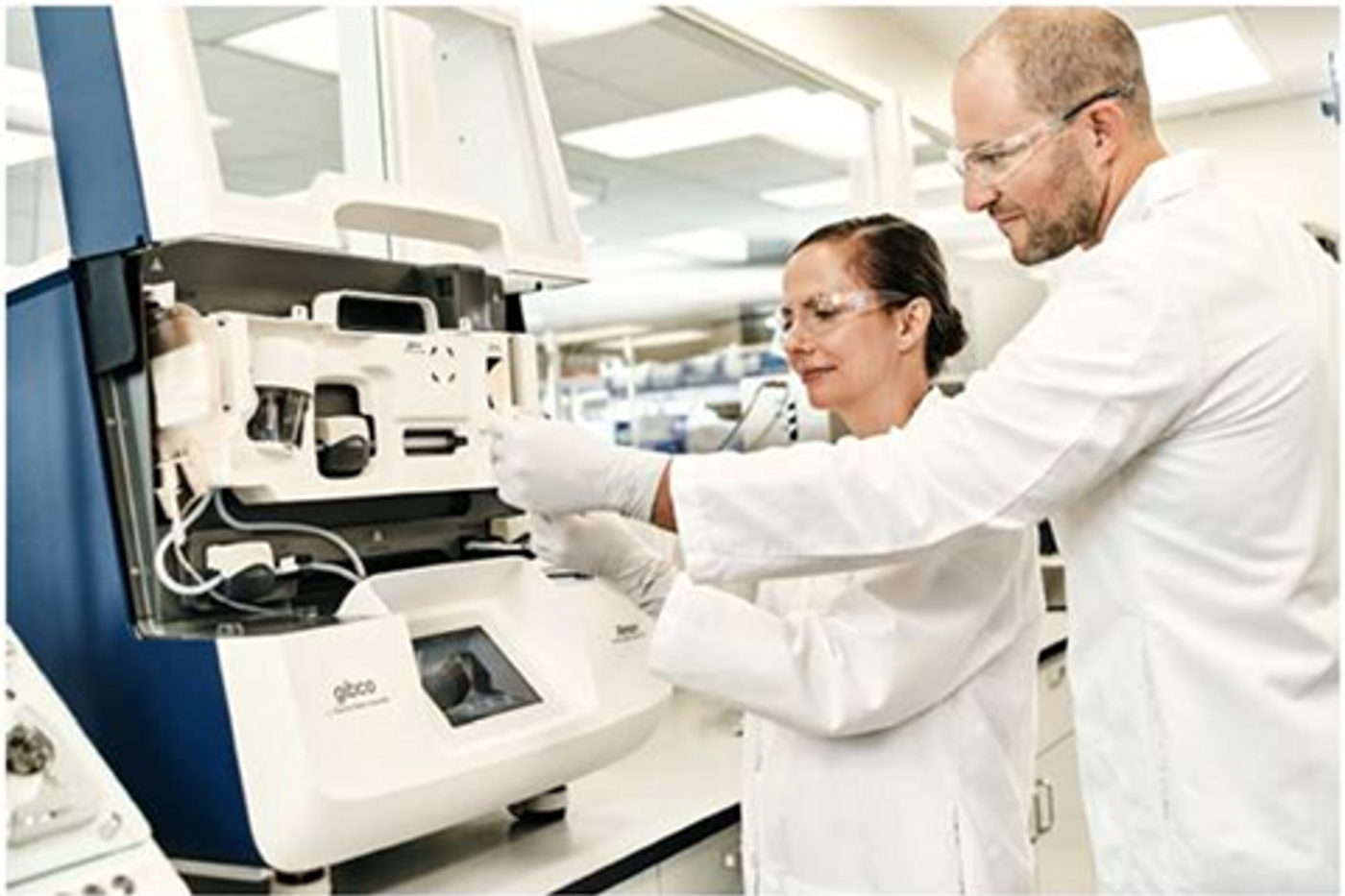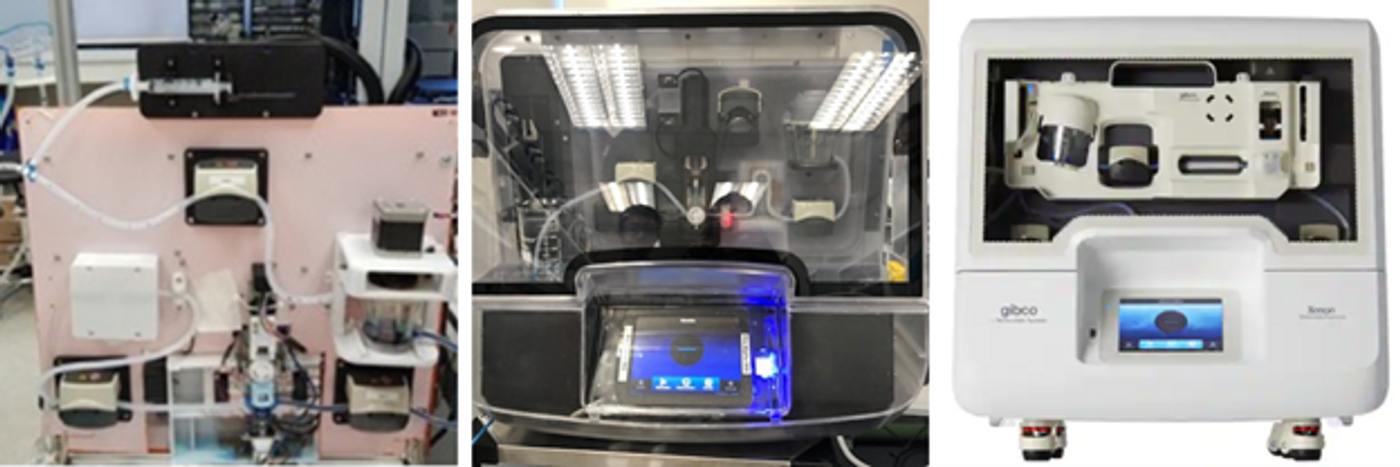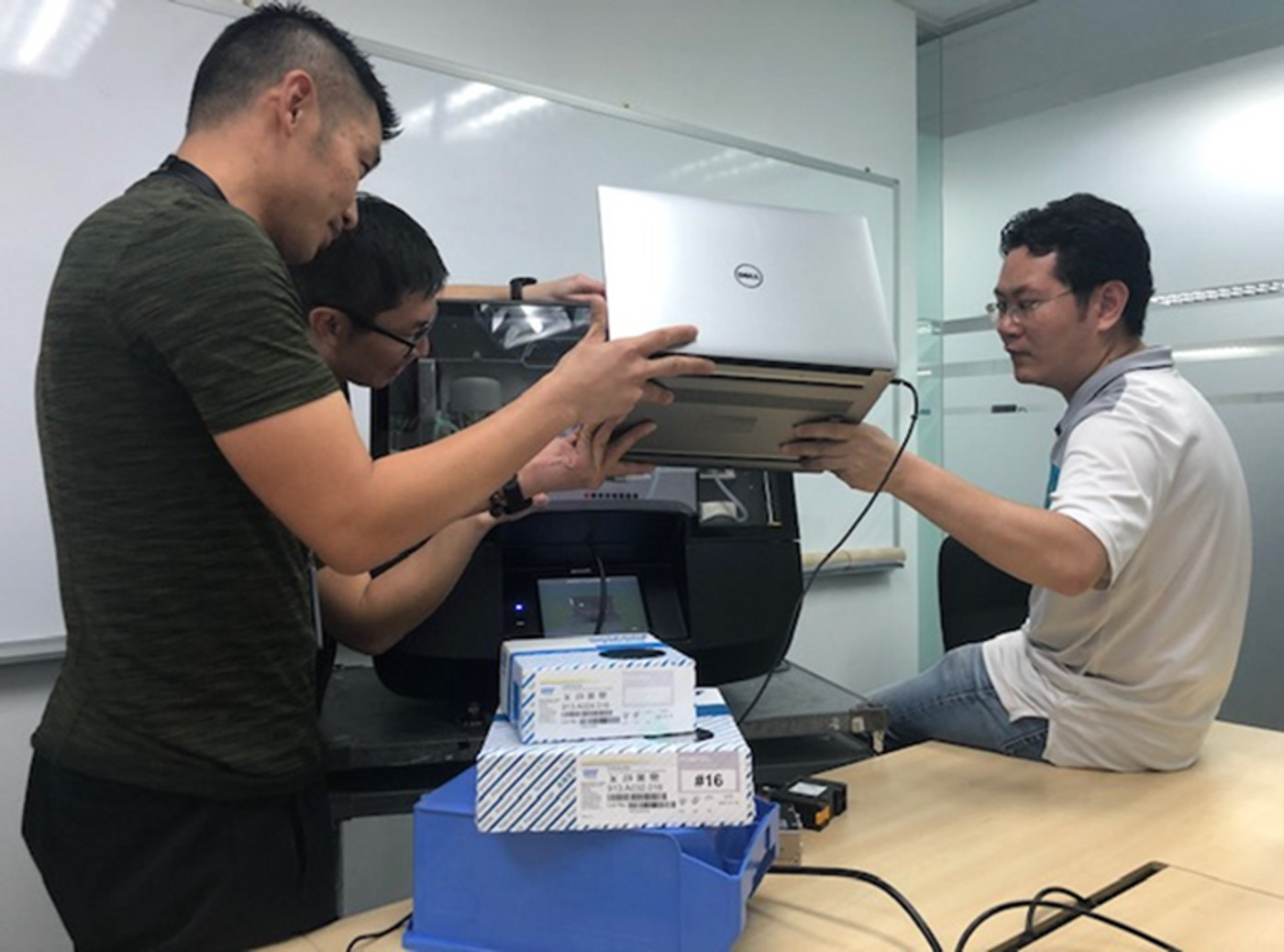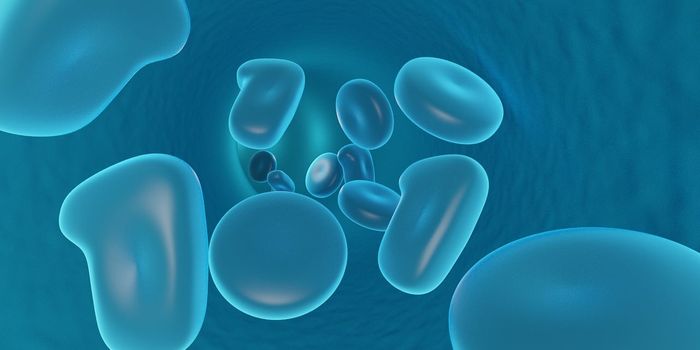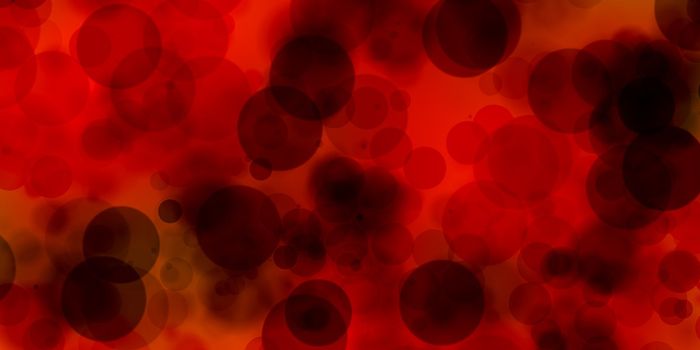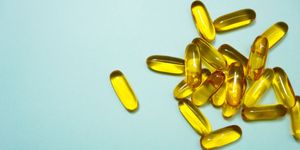Thermo Fisher Scientific Inc. (NYSE: TMO) is the world leader in serving science, with annual revenue of approximately $40 billion. Our Mission is to enable our customers to make the world healthier, cleaner and safer. Whether our customers are accelerating life sciences research, solving complex analytical challenges, increasing productivity in...
Customer-Led Innovation: Building the CTS Xenon
How customers and R&D scientists came together across oceans and a pandemic to create a next-gen cell therapy solution
Thermo Fisher Scientific scientists Nektaria Andronikou (left) and Mike Gordon (right) with the CTS Xenon Electroporation System instrument and MultiShot cartridge.
Few emerging fields today are as exciting as cell and gene therapy. 2021 was a banner year for the number of gene therapy and gene-modified cell therapy products approved to market and 2022 is on a similar track1.
We’re now seeing the industry pivot towards a new frontier of potentially safer, non-viral mediated approaches to clinical advancement. As pioneering research in the cell therapy space progresses, so does the need for scaled solutions in process development and clinical manufacturing. All eyes are on better, safer, faster solutions.
Electroporation, a physical method of transfection, is a great, non-viral technique for delivering large payloads of DNA, RNA, or protein quickly. Scaled up effectively, it could be just what the cell therapy field has been missing.
"Electroporation in cell therapy is growing like crazy. Every customer that we know of that has been working with viral vectors is exploring or has programs using non-viral based cell therapy, of which electroporation is used majority of the time,” said Don Paul Kovarcik, Senior Product Manager for Cell Therapy Systems at Thermo Fisher Scientific.
The GibcoTM CTSTM XenonTM Electroporation System is a tool that promises to help fuel this new era of cell therapy production and enable access to more people than ever before.
Its recent invention is at its heart a story of customer-led innovation and passionate problem-solving on the part of Thermo Fisher Scientific R&D team members and collaborators. Together, these key players worked across continents to make a difference for those affected by cancer.
GO BIG OR GO HOME
To understand how the CTS Xenon system got its start, we need to begin with its predecessor, the InvitrogenTM NeonTM Transfection System. The Neon system is a portable benchtop electroporation model that customers across the life sciences have used for years for non-viral transfection.
For most things, including cell therapy research, the Neon system works well. But the Neon is an open system, unsuitable for a clinical manufacturing setting.
“Customers were saying, ‘Well we like the Neon Transfection System, but we really need a bigger version of it.’ The Neon suits the needs of the research and discovery space, but it really wasn’t designed for cell therapy in terms of volumes, and it lacks the quality and regulatory requirements that are necessary to use in the GMP manufacturing environment,” said Kovarcik.
A complementary instrument would also open the door for a fully seamless translation from research to manufacturing.
The big question was, how could the team scale up the Neon system without changing the workflow experience?
It sounds deceptively simple – take what works and make it bigger. But it’s not that straightforward. There were major engineering challenges and physical limitations to scaling the Neon system. When you close the electroporation system to make it sterile, suddenly, there are new factors like pressure and temperature to accommodate in the design.
“We started to learn that things happen differently when you apply that energy in a closed system,” said Nektaria Andronikou, one of the project’s lead scientists with Thermo Fisher Scientific. “The Neon consumable is open on the bottom so pressure buildup can escape.”
In early prototypes of the CTS Xenon system, unchecked pressure and heat buildup within the electroporation chamber was creating a bubble of air that in turn triggered electrical arcing, frying the sample cells in the process.
Steven Yeo, the project’s technical lead for the instrument and plastic consumables, estimated that 80% of the hurdles in the CTS Xenon’s early development came down to this single, stubborn bubble disrupting current.
“Once we apply voltage, the sample gets heated up and the pressure increases. We created a chamber design that is completely sealed and able to withstand that pressure, and it solved the bubble and arcing issues,” said Yeo. “This issue alone triggered about ten design iterations and about half a year of work. That might seem to be on the high side, but we really tried a lot of iterations to get it exactly right.”
Caption: Development stages of the CTS Xenon system, in evolution from left to right: early concept of the electroporation system (left); alpha stage working prototype for consumer testing (center); final CTS Xenon system with MultiShot cartridge (right).
>> Take an interactive, 3D tour of the CTS Xenon Electroporation System
CUSTOMERS LEAD THE WAY
Andronikou estimates that close to a hundred researchers have touched the CTS Xenon system from start to finish of its development, with each person bringing unique expertise so that no aspect was overlooked.
Perhaps the most critical expert perspective in the CTS Xenon system’s development, however, came from the one key player that the research team didn’t have in-house: the customer.
“We had a lot of back and forth with key customers,” said Andronikou. “We went to customers with cardboard cutouts of early prototype concepts and asked them, would this work? We asked for their honest input – would this kind of cartridge style work? And I think we did three or four rounds of that to make sure that we had an intimate understanding of their needs and what kind of system and workflow would suit them best.”
Nearly every feature in the CTS Xenon system can be traced back to an element of customer feedback and an incredible attention to detail paid by the R&D team, who went through half a dozen iterations with customer teams before they arrived at the system’s final form.
“Every aspect of the consumables has been thought through. The holding features on the MultiShot. The mixer cup, and the way it’s tilted to make sure that the customer can drain every last bit of sample. The flow going from left to right–it used to loop back in earlier iterations, and engineering quickly changed that after getting feedback from customers about how it affected processing time,” said Andronikou.
The team considered every type of feedback, at all stages of design. Some things were less about technical improvements and more about the unique, emotional nature of working with such a priceless sample as a cancer patient’s cells.
“When we were doing concept testing, we had customers indicate to us that they really wanted to be able to see what was going on inside the instrument,” said Kovarcik. “These samples are precious. Customers wanted to stand there like concerned parents and watch the sample flow through the system. We had a cartridge design concept where you couldn’t really see anything, and they felt blind and a little bit scared that if something were to go wrong, they wouldn’t know. So we moved to a kind of ‘aquarium design’ where you can actually see into the instrument.”
Caption: Thermo Fisher Scientific systems engineer Way Xuang Lee (left) discusses an early concept prototype of the CTS Xenon system with cell biology manager Yvonne Peck (right).
A STRONG CONVICTION
The CTS Xenon system also features two single-use electroporation options: the 1 mL SingleShot chamber and 5-25 mL MultiShot cartridge. These sterile consumables can help reduce operator error and limit sample contamination.
A research-use only Multishot cartridge launched in July 2022, and a GMP-compliant version is expected to follow later this year after completion of extensive product-related testing.
The team worked to ensure that the SingleShot and MultiShot cartridges were identical in performance, a critical requirement from the customer side.
In an impressive first for the business, the global R&D team also banded together to invent all the vital parts of the CTS Xenon system simultaneously – reagent, consumable cartridges, software, and instrument – to create a cohesive, modular, one-of-a-kind system that preserved the best parts of the Neon and improved on others.
Like so many of the other cell therapy workflow solutions offered by Thermo Fisher Scientific, the CTS Xenon system design and modular setup is sleek and effective. Users can load up their favorite protocols from a touchscreen and receive a speedy and standardized product every time, exactly the way they prefer it for their experimental needs. Unlike other large-scale electroporation systems on the market, users can control every experimental parameter of the CTS Xenon system, including voltage and pulse width, interval, and number.
“Customers really like the ability to control those parameters and having visibility as to what the parameters are,” said Kovarcik.
The closed system’s combined scale and customizability fills a key gap in cell therapy manufacturing in a way that no other tool has to date.
“I’d like to think that this is one critical piece in a big puzzle that’s starting to find all of its pieces right now,” said Andronikou. “Honestly, it’s surreal. You’ve worked on something for so long, the thought that it’s actually going to be incorporated into a therapeutic to potentially cure cancer…I don’t know if it’s sunken in yet.”
Andronikou has been a part of the CTS Xenon system R&D team from day one, more than five years from concept to launch. She joked that she probably has as many photos of the instrument on her phone as she does of her kids.
Every core member of the CTS Xenon R&D group also said the same thing: they are a strong, close-knit team that works well together.
“Throughout this whole development, the team has faced a lot of challenges. You know, at first we couldn't get it working,” said Yeo. “But we know that this product is meant for personalized medicine and cell therapy. I mean, we look at the incredible stories of children who have gone into remission—we know that they are cancer free after getting [cell therapy] treatment. It has made the whole team have a very strong conviction that we want to get this thing working, because we know that we can help.”
Caption: Thermo Fisher Scientific R&D engineers Way Xuang Lee (left) and Wei Han (right) in Singapore discuss an early concept of the CTS Xenon system instrument with international colleagues via remote video meeting.
INNOVATING THROUGH A PANDEMIC
Another challenge through the innovation process is one that no one could have predicted when the project first kicked off in 2016: a historic global pandemic and subsequent quarantine. Meaningful collaboration had to happen between continents in the form of twilight-hour video calls between Thermo Fisher Scientific R&D staff in California and Singapore, and cell therapy customers all over the world.
“As researchers, we are spanned across two time zones,” said Andronikou. “Sometimes we just couldn’t wait, and everyone has had that sense of urgency and intensity and passion on this project.”
Andronikou and the others charged through the obstacles because they are incredibly passionate about what they’ve built and the impact that it will have downstream for real-life patients like Emily Whitehead. With the time zone split, the project was live 24/7.
In Singapore, research staff were classified as essential workers by the government and permitted to work on-site in small teams.
Lead systems engineer Way Xuang Lee staggered his schedule with other important team members like Yeo, so that if one fell ill with COVID-19, the other would not be impacted and the project could continue.
“We strategized everything–working in different teams, different locations, coming up with a plan where everyone could execute on the same thing,” said Lee. “One day, staff would come in to fix the mechanical parts. The next day, the electrical guys would come in and wire everything up for the mechanical guys to put back together. Then the firmware guys would come in and try to boot up the instruments before the testing guys took over.”
Despite all the obstacles, the team's work paid off. The CTS Xenon instrument was released to market in March of 2022.
"At each stage of development, we hit a bottleneck. We hit issues that we never expected, so it's surreal that it's out there in the market. It feels nice,” said Lee. “Overall feedback from the customers is that they are generally very pleased with the performance, which is what really matters. Because ultimately, performance is what translates to output, and that output is what can help save lives."
Yeo hopes one day to hear about a patient who is able to overcome their illness because of a therapy produced in part with the use of the CTS Xenon system.
For Andronikou, this year’s successful launch into the marketplace means the best is yet to come.
“The most exciting part for me was when I got the unit that looked like the final product. It arrived here in Carlsbad. We were unboxing it and I couldn’t help taking pictures. I thought, this has been my life, our lives, for the past how many years? I was so happy and proud to be part of this team. And most of all, excited to get it into the marketplace to make a difference, because we know it works,” said Andronikou.
>> Learn more about the CTS Xenon system at thermofisher.com/xenon.
12021 Annual Report. Washington, DC: Alliance for Regenerative Medicine, 2022. https://alliancerm.org/sector-report/2021-annual-report/
